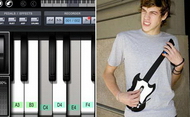New media, old messages
Within a darkened installation space, a group of autonomous but sociable robotic sculptures perform a "dance" with their illuminated tails.
They negotiate with their audience, to attract and maintain their attention.
The third part, Zone of Impending, puts the focus on ecosystems and environments upon which all life depends, calling attention to the plight of ecological disruption.
Champs d'Ozone, an artist group from France, the United Kingdom and Germany, exploits data that measures the quality of air in Beijing, provided in quasi real time by a Weather Tunnel installed at the main entrance of the museum, and then transposes the information in a visual and sound space-time continuum.
In this device, a computer-generated cloud appears to hang over the city, saturated but always changing color, reflecting the concentrations of nitrogen dioxide, sulphur dioxide, ozone, and particle dust suspended in the air.
"Could a red cloud be more toxic than an orange one? Might there be such a thing as zero pollution? The reading of the cloud is left to the viewer to decipher," artist Helen Evans with the artist group says.
In her installation work Plant (iPod), Canadian artist Jane Tingley tries to create new relationships between human and plant life.
Her works, comprising eight plant/prosthetic objects of various shapes and sizes, are spread throughout the exhibition hall.
Each of the objects includes a built-in subwoofer with metal branches rising from it that hold two small speakers close to the leafy part of the plant, which together function as a sound system. Each object contains both sensors and speakers, so that the sound being played to the plants is directly affected by the viewer's location and proximity.
"The work evokes the possibility of developing technologies that are nature-centric rather than human-centric and reinvents the idea of the enchanted forest," Zhang, the curator, says.
To help visitors understand the exhibits better, the organizers have arranged for seminars and lectures by curators, scholars and artists, as well as on-site explanations by young volunteers who themselves are mostly media art majors, museum director Fan says.
New media art is still young in China, Fan points out.
New media art works are more complex than video or animation; and the creative process usually demands the collective efforts of artists, engineers, architects and scientists, he explains.
Of the exhibits on display, only five are from mainland artists, including two from the newly founded Art and Science Center Media Lab at Tsinghua University in Beijing.
The exhibition ends on Thursday in Beijing.
Source: China Daily
Editor: Xu Xinlei

